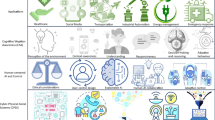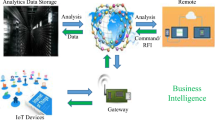Abstract
The ambient intelligence consists of the integration of computer science technologies in the objects of the environment around us in order to create a smart one. Each object in the environment performs a different service as part of achieving a task. The adaptive Service composition is a context-aware system used in the situation where the user’s needs cannot be satisfied by a single service but by the combination of several ones. One of the main and principal characteristics of ambient environments is the adaptability to the context. The multi-agent systems with their characteristics of autonomy, proactivity, mobility and sociability are one of the most promising techniques of service composition and they became a major and significant paradigm for developping ambient systems. In this paper, we present a model of adaptive service composition in ambient environment based on multi-agent system named Multi Agent System for Adaptive Service Composition (MAS-ASC). To each object of the environment is associated an agent. The set of the agents coordinate their competences taking into account the context in order to perform an activity. MAS-ASC is based on the Contract Net Protocol in which the agents exchange their proposals in the form of call for proposal. It is implemented on Java Agent DEvelopment framework platform and has been tested to economize the consumption of energy in an intelligent lighting system example.
















Similar content being viewed by others
References
Andriatrimoson A (2012) Assistance robotise la personne en environnement cooprant. Doctoral Dissertation, Universit d’Evry-Val d’Essonne
Baldauf M, Dustdar S, Rosenberg F (2007) A survey on context-aware systems. Int J Ad Hoc Ubiquitous Comput 2(4):263–277
Bellifemine FL, Caire G, Greenwood D (2007) Developing multi-agent systems with JADE, vol 7. Wiley
Bellifemine F, Poggi A, Rimassa G (1999) JADEA FIPA-compliant agent framework. In: Proceedings of PAAM, vol 99, No. 97–108, p 33
Benavente Peces C, Ahrens A, Filipe J (2014) Advances in technologies and techniques for ambient intelligence. J Ambient Intell Hum Comput 5(5):621–622
Chaib A (2011) Composition automatique et semi automatique des services Web semantique Par lutilisation des techniques de planification distribuees Les Systemes Multi Agents. Master Thesis Universite de setif, Algerie
Chaib A, Boussebough I, Chaoui A (2015) Multi-agent system in ambient environment for assistance of elderly sick peoples. In: Proceedings of the international conference on intelligent information processing, security and advanced communication, ACM, p 21
Chaouche AC, Ili JM, Sadouni DE (2016) A Guidance of Ambient Agents Adapted to Opportunistic Situations. In: International symposium on intelligent and distributed computing. Springer International Publishing, pp 47–56
Charif Y (2007) Chorgraphie dynamique de services base sur la coordination d’agents introspectifs. Doctoral Dissertation, Paris, p 6
Chen T, Chan CC, Wu HC, Lin YC (2015) Ambient intelligence and ergonomics in Asia. J Ambient Intell Human Comput 6:1–2
Cook DJ (2009) Multi-agent smart environments. J Ambient Intell Smart Environ 1(1):51–55
Corchado JM, Bajo J, De Paz Y, Tapia DI (2008) Intelligent environment for monitoring Alzheimer patients, agent technology for health care. Decis Support Syst 44(2):382–396
Coutaz J, Crowley J (2008) Plan intelligence ambiante: dfis et opportunits. Document de rflexion conjoint du comit dexperts Informatique Ambiante du dpartement ST2I du CNRS et du Groupe de Travail Intelligence Ambiante du Groupe de Concertation Sectoriel (GCS3) du Ministre de lEnseignement Suprieur et de la Recherche 1
De la Prieta F, Bajo J, Rodríguez S, Corchado JM (2017) MAS-based self-adaptive architecture for controlling and monitoring Cloud platforms. J Ambient Intell Human Comput 8:213–221
Dujardin T, Rouillard J, Routier JC, Tarby JC (2011) Gestion intelligente dun contexte domotique par un Systme Multi-Agents. Universit Lille
Ferber J (1995) Multi-agent systems: vers une intelligence collective. Interedition, Reading
Ferrando SP, Onaindia E (2013) Context-aware multi-agent planning in intelligent environments. Inf Sci 227:22–42
Grisey A, Pommier F, Chantry N, Piasentin J, Chasseriaux G (2007) Utilisation rationnelle de lenergie dans les serres situation technico-economique. Etude realisee pour le compte de l ADEME par le Ctifl, l Astredhor et l INH
Gutierrez-Garcia JO, Sim KM (2013) Agent-based cloud service composition. Appl Intell 38(3):436–464
Hu X, Du W, Spencer B (2011) A multi-agent framework for ambient systems development. Proced Comput Sci 5:82–89
Landau R (2013) Ambient intelligence for the elderly: hope to age respectfully? Aging Health 9(6):593–600
Lee J, Ma SP, Lin YY, Lee SJ, Wang YC (2008) Dynamic service composition: a discovery-based approach. Int J Softw Eng Knowl Eng 18(02):199–222
Moraitis P, Spanoudakis N (2007) Argumentation-based agent interaction in an ambient-intelligence context. IEEE Intell Syst 22(6):84–93
Olaru A (2011) A context-aware multi-agent system for AmI environments. Teza de doctorat
Remagnino P, Hagras H, Monekosso N, Velastin S (2006) Ambient intelligence: a Novel paradigm, p 1
Santofimia MJ, Moya F, Villanueva FJ, Villa D, Lopez JC (2008a) An agent-based approach towards automatic service composition in ambient intelligence. Artif Intell Rev 29(3–4):265–276
Santofimia MJ, Moya F, Villanueva FJ, Villa D, Lopez JC (2008b) Integration of intelligent agents supporting automatic service composition in ambient intelligence. In: Proceedings of the 2008 IEEE/WIC/ACM international conference on web intelligence and intelligent agent technology. IEEE Computer Society, vol 02, pp 504–507
Smith RG (1979) A framework for distributed problem solving. In: Proceedings of the 6th international joint conference on artificial intelligence, vol 2. Morgan Kaufmann Publishers Inc., pp 836–841
Weiser M (1993) Some computer science issues in ubiquitous computing. Commun ACM 36(7):75–84
Zhang Y, Huang GQ, Sun S, Yang T (2014) Multi-agent based real time production scheduling method for radio frequency identification enabled ubiquitous shopfloor environment. Comput Ind Eng 76:89–97
Zhang Y, Qian C, Lv J, Liu Y (2017) Agent and cyber-physical system based self-organizing and self-adaptive intelligent shopfloor. IEEE Trans Ind Inf 13(2):737–747
Zhou J, Riekki J, Ylianttila M (2009) Modeling service composition and exploring its characteristics. In: 2009 congress on services-I. IEEE, pp 446–451
Author information
Authors and Affiliations
Corresponding author
Rights and permissions
About this article
Cite this article
Chaib, A., Boussebough, I. & Chaoui, A. Adaptive service composition in an ambient environment with a multi-agent system. J Ambient Intell Human Comput 9, 367–380 (2018). https://doi.org/10.1007/s12652-017-0510-8
Received:
Accepted:
Published:
Issue Date:
DOI: https://doi.org/10.1007/s12652-017-0510-8




